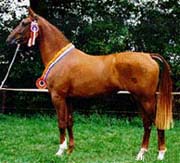Dutch Warmblood
N/A
Sat, 12th July, 2025 - 5:38 am GMT
Sponsor Ads:

Alternative Name
N/ABasic Info
Dutch Warmblood horses average about 16.2 hands with some reaching 17 hands. Coat colors are chestnut, bay, black or gray with white markings often on the face and legs. The head is well shaped, usually with a straight profile, and the neck is arched and well muscled, merging neatly into the withers, which are fairly prominent. The back is straight and fairly long, with the croup short, broad and flat. The tail is set high. The chest of this horse is deep and full and the shoulder is well sloped. The legs are strong with a long forearm. Hind quarters are powerful and highly muscled, a characteristic inherited from the original and powerful farm horses of the Netherlands and a feature necessary for strong movements
Health
N/AHabitat
N/ABehavior
Dutch Warmbloods are bred to perform in dressage and show jumping at the highest level. These horses are appealing modern horses, with great eagerness, reliability and intelligence.Origin
NetherlandHistory
The Dutch Warmblood is a "warmblood sport horse" breed. Warmblood simply distinguishes this type of horse from the "cold bloods" (draft horses) and the "hot bloods" (Thoroughbreds and Arabians). Sport horse refers to the intended use of the breed -- as a competitive and recreational horse for the major international equestrian disciplines of dressage, jumping, three-day event and driving. Most warmblood breeds are continuing to evolve. In fact, they are not "breeds" in the sense that Thoroughbreds, Arabians, Morgans and Saddlebreds are breeds. They do not have closed studbooks. Other breeds are often introduced to the gene pool to reap the benefits of hybrid vigor, and to speed and improve the evolutionary process of attaining the "Breeding Goal" of the particular studbook. The Dutch Warmblood is no exception. The Dutch Warmblood is a modern sport horse derived from the selective breeding of German, French, and English horses crossed with the native Dutch stock. The roots of the Dutch Warmblood are deep in two areas of Netherlands soil -- Gelderland and Groningen. In Gelderland, located in the central Netherlands, the soil is sandy, and here the lighter type of horse developed. In Groningen on the other hand, where the soil is heavy clay, a much heavier and denser horse was produced. The two remained genetically compatible and to refine their horse Groningen breeders used Gelderlanders, while in order to add more mass to the Gelderlander, Groningen blood was used. Dutch farmers earned their living with horses, so strict breeding practices have long been used. Faults in soundness and character were quickly eliminated, along with horse that lacked intelligence. This severe culling made a great contribution to the Dutch Warmblood of today. As mechanization of equipment gradually caused the horse to become superfluous on farms, riding clubs became more popular and interest in the sport horse increased steadily. Using the fine old established bloodlines, the Dutch changed direction in their horse breeding to develop a true riding horse. Thoroughbred stallions were used, as well as riding-type stallions from France, Holstein, Hanover and elsewhere, with breeders taking care to retain time-tested farm horse qualities of the old Dutch breeds. Hackney horses were also introduced in order to produce a stylish harness horse. Other breeders continued to breed the traditional Gelderland light draft horse. As a result, the modern Dutch Warmblood horse is designated into three categories within the KWPN Studbook: sport horse, harness horse and traditional Gelderland type. These horses are high achievers, but achievements are not permitted to overshadow the good conformation, beauty or charm that have made the Dutch horses famous. In a relatively short time the modernized Dutch sport horse has rocketed to international competitive importance. Dutch Warmblood horses, famous for their character, soundness and athletic ability, are exported to all corners of the globe, and are international winners under the flags of many different nations in international competitions and Olympic Games.Common Foods
grassSponsor Ads:
Declare war on passivity. Hush the inner voice that insists you're over the hill, past your prime, unworthy of attaining those dreams. Disbelief is now the enemy, as is the notion of settling. Get hungry - hyena hungry. Get fired up. Find your backbone, and your wings. Flap 'em. It's the only way you'll be able to fly. -- J.C. Hutchins, What matters now, Pg 81
Dutch Warmblood
Coded by: BGID® | ALL RIGHTS RESERVED Copyright © 2000-2025
Disclaimer | Privacy | Report Errors / Contact | Credits
















